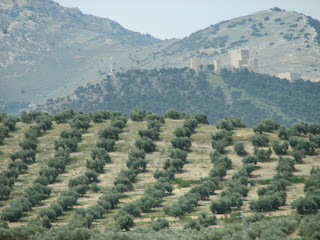
Spring has arrived in Barcelona! The trees are in bloom and the warmer weather (low 70s) feels great. This is the entrance to our apartment builing.


We've spent most of the past three months in the routine of school, dinner, bed, weekend. Repeat. Here are the kids Monday morning on the way to school. And here they are Sunday night eating popcorn and watching Spanish TV, which is their way of preparing for the upcoming week. While it's routine, we love it!
Since so much has happened in the past 3 months, I will let the pictures speak for themselves and simply list the highlights.
*Sarah and 4 mothers of Daniel's classmates form "cooking club." Teach each other how to cook a meal from our native countries which are Spain, Italy, Ecuador, Bosnia and USA.
*Duane and Sarah begin teaching weekly English classes to friends at church.
*Charles begins intermural soccer. Games at other schools give us opportunity to see new places around Barcelona.
*First parent/teacher conferences.
*We learn that in the mornings, just off school grounds, companies frequently pass out free toys to advertise their products. It works and the obsession with "Invizimal" stickers begins! The stores are out of them for days!


*The boys celebrate Carnestoltes (Mardi Gras) at school. Charles is a Barcelona soccer player. Daniel is Darth Vader.

*After school visits to the neighborhood bakery begin. This morphs into getting a pack of Invizimal stickers instead. They are SO much more exciting than chocolate-covered croissants.

*Alicia, the portera (door woman for our building), begins doing our laundry in another apartment, which HAS a laundry machine, and brings the wet clothes back to Sarah to hang up on the line. As long as no one is staying in the upstairs apartment, Sarah doesn't have to do the laundry by hand.

*We venture to the country, in the foothills of the Pyrenees, to celebrate a Calcotada with Duane's colleagues. This is a traditional Catalonian "onion festival" where one eats burnt leek-like plants called calcots which are served on a clay roof tile.


*Duane travels to the USA twice and also to a conference in Chile's Atacama Desert. Grandpa arrives the same day Duane departs. They meet in the airport and Duane gets on the SAME plane which flies back to the USA!
*Grandpa, Sarah, Charles and Daniel travel to Paris and London.


These are pictures
in front of Notre Dame Cathedral,
in line to walk up the Eiffel Tower,
in front of Big Ben, and
inside a London telephone booth.



















































